Veterinary Disclaimer: This content is for informational purposes only and does not substitute professional veterinary advice. Always consult your veterinarian before changing your dog’s diet or diagnosing allergies.
Table of Contents
Introduction
If your dog is constantly scratching, chewing their paws, or battling chronic ear infections, you might be dealing with a food allergy. As a small animal vet in Ottawa, I’ve helped dozens of frustrated owners finally get relief for their pets — and it often starts with choosing the right dog food for allergies. The right diet can dramatically reduce symptoms in as little as 6–8 weeks, and bring comfort back to your dog’s daily life. Let’s explore what really works and how to do it safely.
Key Takeaways
- Dog food for allergies should contain either hydrolyzed or novel proteins to avoid triggering immune reactions.
- The most common allergens are proteins like beef, chicken, and dairy — not grains.
- Flea allergies, infections, or atopy can mimic food allergies — diagnosis requires a proper workup.
- An elimination diet trial is the gold standard for diagnosis, not blood or saliva tests.
- Homemade diets can help allergic dogs, but only when balanced with veterinary guidance and supplements.
- Long-term allergy management means avoiding the problem ingredient completely — even in treats and meds.
✅ Veterinarians typically recommend prescription or vet-guided diets as the most effective dog food for allergies.
Signs Your Dog May Have a Food Allergy
Food allergies in dogs don’t usually cause sneezing or watery eyes like they do in humans. Instead, they tend to show up through chronic skin problems or digestive upset. If your dog’s symptoms persist despite flea control and standard treatment, it might be time to evaluate their dog food for allergies.
Common Skin and Digestive Symptoms
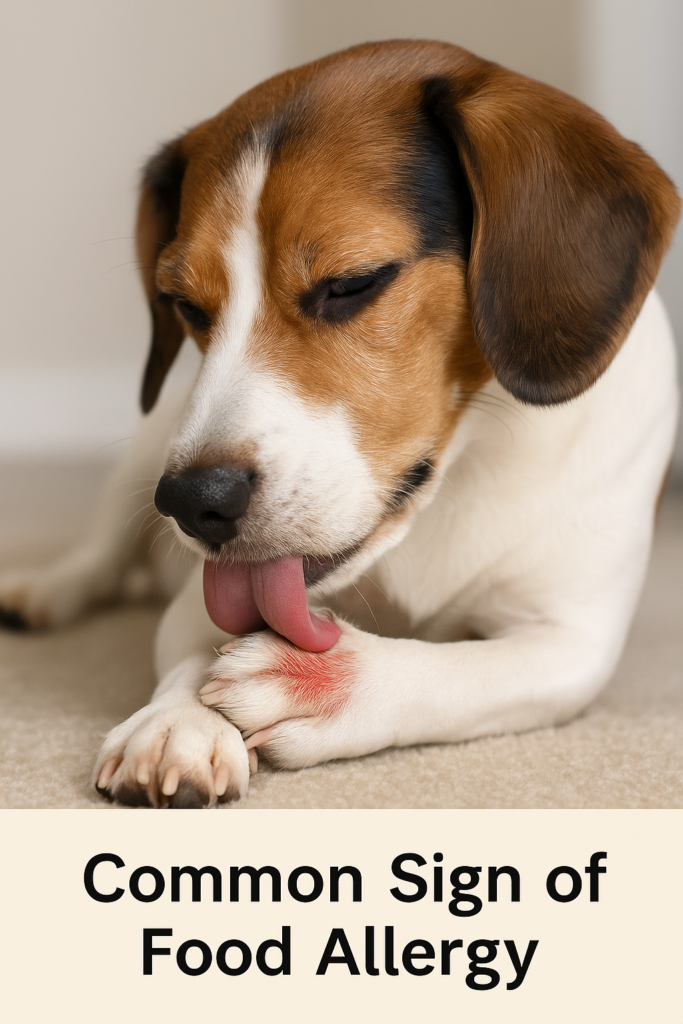
These symptoms can develop gradually and persist year-round:
- Itchy skin — especially around the face, paws, belly, and tail base
- Red or inflamed ears, often recurring infections
- Frequent paw licking or chewing
- Vomiting or diarrhea, especially after meals
- Chronic soft stools or excessive gas
- Anal gland irritation
- Rubbing face on carpets or furniture
In my practice, one Labrador had year-round ear infections that resolved completely after switching to a hydrolyzed dog food for allergies — proof that food can be the root cause.
Conditions That Mimic Food Allergies
It’s crucial to rule out more common issues before committing to a diet trial. These include:
- Flea allergy dermatitis — still the most common cause of skin issues
- Environmental allergies (atopy) — pollen, dust, molds
- Yeast or bacterial skin infections
- Mites (mange) or intestinal parasites like Giardia
- IBD or other chronic GI disorders
Only after these are ruled out should your vet recommend a diagnostic dog food for allergies trial.:
Common Food Allergens in Dogs
Most food allergies in dogs are triggered by proteins — not grains or artificial additives. Even premium or “natural” diets may contain problematic ingredients, so choosing the right dog food for allergies takes careful label reading and guidance from your vet.
Top Offenders: Proteins
Research shows that these ingredients cause the majority of food allergy reactions in dogs:
- Beef
- Chicken
- Dairy (milk, cheese, yogurt)
- Eggs
- Lamb
- Fish (occasionally)
Beef and chicken are the most frequently implicated. Many standard and “limited ingredient” foods still include them, so it’s crucial to check what proteins are in your current dog food for allergies.
Less Common Triggers
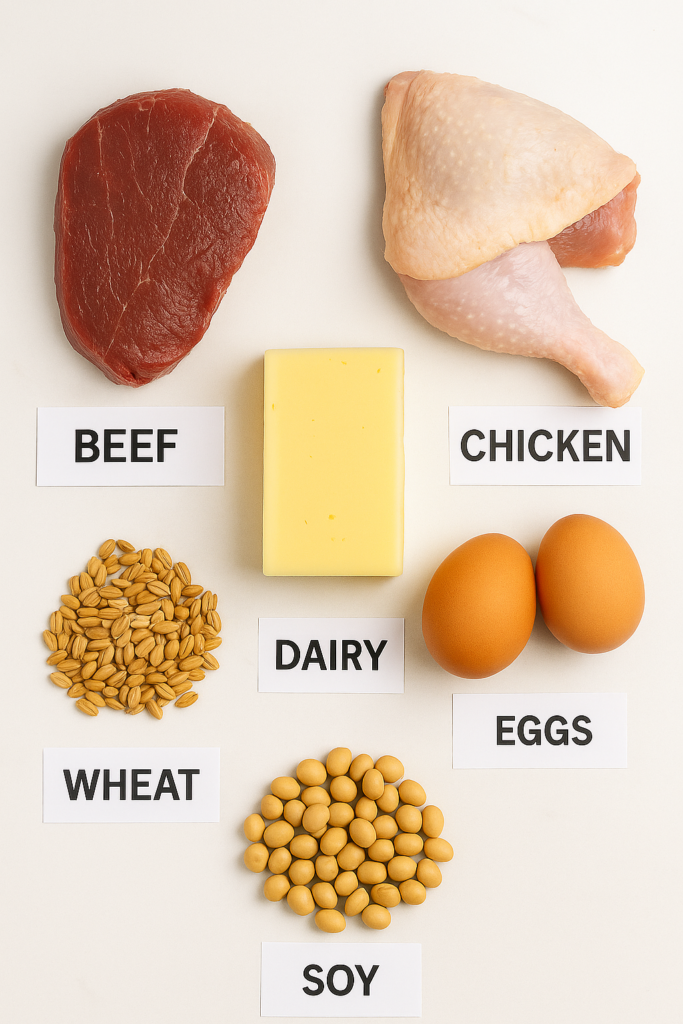
Some dogs react to:
- Soy
- Wheat (especially gluten)
- Corn
- Legumes like peas and lentils (in rare cases)
- Food additives or preservatives (less common as true allergens)
These are less likely than proteins to cause true food allergies but can worsen symptoms in dogs with sensitive guts or skin.
Debunking the Grain-Free Myth
It’s a common misconception that grain-free automatically means hypoallergenic. But most dogs with food allergies react to proteins — not grains.
Some grain-free formulas replace grains with lentils or chickpeas, which can be harder to digest. They’ve also been associated with diet-related heart disease in certain breeds.
Bottom line: Unless your dog is truly grain-allergic (rare), a grain-inclusive dog food for allergies may be just as effective — and safer.
How Vets Diagnose Food Allergies
Diagnosing food allergies isn’t as simple as sending off a saliva or blood sample. In veterinary dermatology, the only reliable method is a carefully controlled elimination diet. If you’re serious about finding the best dog food for allergies, this is where it starts.
Why Elimination Diets Work
An elimination diet removes all known proteins your dog has eaten before. You’ll feed:
- Hydrolyzed protein diets (e.g., Hill’s z/d, Royal Canin HP) — where proteins are broken down so small that the immune system doesn’t recognize them.
- Novel protein diets — using proteins your dog has never had (like kangaroo, rabbit, venison) and one carb (like sweet potato).
You must stick to this diet for 8–12 weeks. That means no treats, flavored meds, table scraps, or chews. It’s strict, but I’ve seen amazing transformations — one itchy spaniel stopped licking his feet entirely by week 6 on a veterinary dog food for allergies.
What the Challenge Step Looks Like
After your dog improves, you reintroduce their old food. If symptoms return within days, the diagnosis is confirmed.
Skipping this step may leave you guessing. Always follow through so you’re not left wondering whether the improvement was coincidence or real.
Misleading Allergy Tests
Saliva, blood, or hair tests often promise quick answers — but they’re unreliable. A 2018 study sent in fake samples (including tap water) and still got “allergy results.”
The American College of Veterinary Dermatology and peer-reviewed research (Mueller et al., 2016) agree: these tests are not valid for diagnosing food allergies.
Stick with a vet-recommended elimination diet when choosing a dog food for allergies — it’s the gold standard.
Choosing the Right Dog Food for Allergies
Once your vet confirms a food allergy or strongly suspects one, choosing the right dog food for allergies becomes the foundation of your pet’s treatment. The goal? Feed your dog something their immune system won’t react to — and make sure it’s safe for long-term health.
Hydrolyzed Protein Diets (Prescription Only)
These diets contain proteins broken into tiny fragments (peptides), so the immune system doesn’t recognize them as allergens.
- Examples: Hill’s z/d, Royal Canin Hydrolyzed Protein, Purina Pro Plan HA
- Best for: Dogs with multiple allergies or failed trials on novel proteins
- Vet-exclusive, clinically tested, and typically priced higher
These are often the most effective dog food for allergies and are recommended during the initial elimination phase.
Novel Protein Diets
These use single, rare proteins your dog hasn’t previously eaten, paired with one novel carb.
- Examples: Duck & potato, kangaroo & oats, venison & pea
- Available as prescription (e.g., Rayne Kangaroo) or over-the-counter (e.g., Natural Balance LID)
- Cross-contamination is more common in non-prescription versions
OTC versions may be tempting due to price but can contain traces of other proteins — potentially triggering allergic flare-ups.
Limited Ingredient Diets (LID)
These are simplified commercial diets aimed at reducing allergy risk:
- Sold in pet stores and online
- Often labeled “grain-free” or “allergy-friendly” — be cautious
- Not ideal for diagnosis but may help with long-term maintenance
Table: Estimated Monthly Cost of Allergy Diets in Canada (2025)
| Diet Type | Example Brand | Avg. Monthly Cost (CAD, 20kg dog) |
|---|---|---|
| Hydrolyzed (Rx) | Hill’s z/d, Royal Canin HP | $160–$220 |
| Novel Protein (Rx) | Rayne Kangaroo, Purina DRM | $140–$200 |
| Novel Protein (OTC) | Go! Sensitivities, Natural Balance | $100–$140 |
| Homemade (vet-guided) | Custom via BalanceIT + supplements | $100–$160+ |
Price varies by region and retailer — but investing in quality dog food for allergies often saves money on vet visits and medications long term.
Homemade vs Commercial Diets
For some dogs, commercial dog food for allergies may not be enough — especially when multiple allergies are at play. In these cases, a balanced homemade diet can be a game-changer, but it needs to be done right.
When to Consider Homemade Dog Food for Allergies
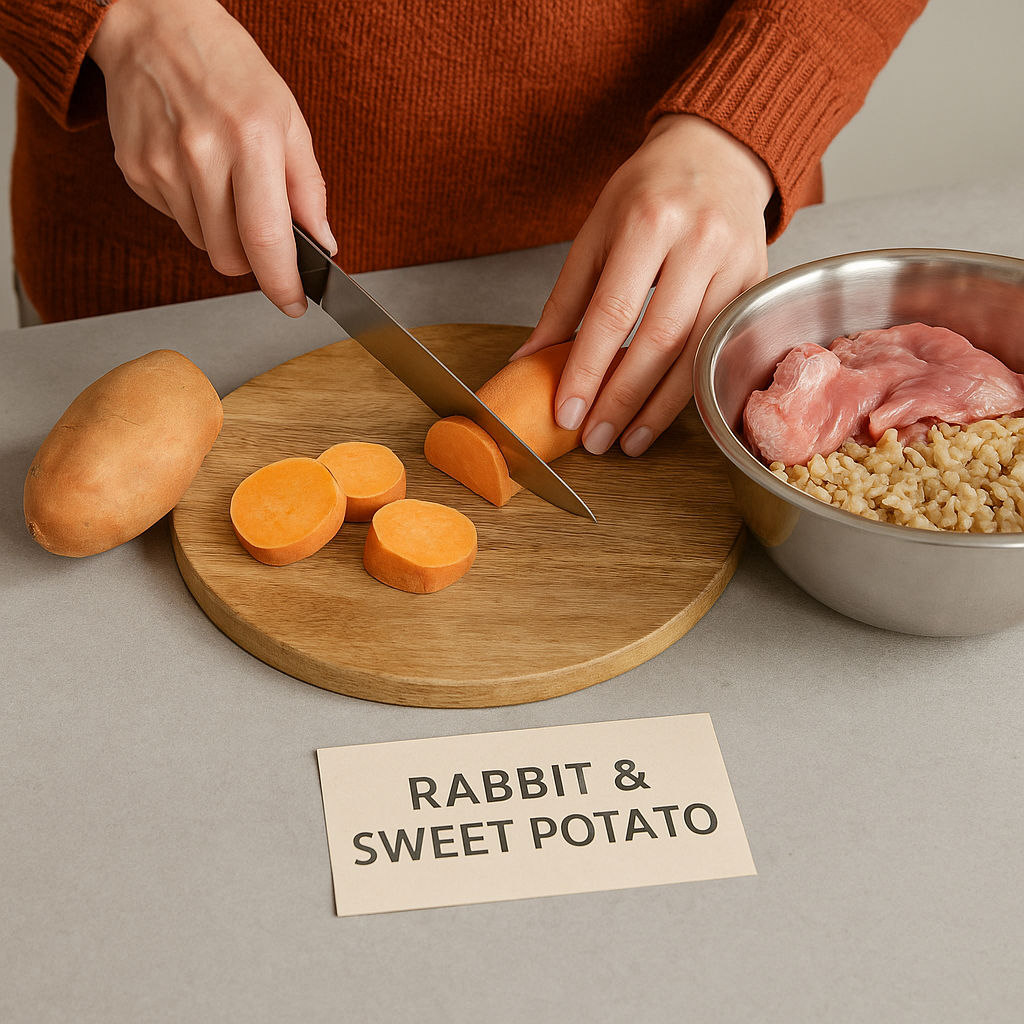
Also read: https://doglifeexpert.com/diy-dog-food-recipes-for-all-3-life-stages/
You might consider home-cooking if:
- Your dog has failed multiple commercial diets
- You want to avoid synthetic ingredients or fillers
- Your pet has multiple health issues needing custom nutrition
- You’re working with a vet or a veterinary nutritionist
In my clinic, I once helped a boxer with both beef and chicken allergies thrive on a homemade venison and sweet potato recipe — but only after consulting with a veterinary nutritionist to ensure it was complete and balanced.
Pitfalls of DIY Meals
Homemade dog food for allergies can be dangerous if it’s not properly balanced. Risks include:
- Vitamin and mineral deficiencies (especially calcium)
- Excess or lack of fat, phosphorus, or protein
- Long-term strain on kidneys, liver, or bones
- Nutritional issues in puppies or seniors
Even recipes found online or from books can be dangerously incomplete.
Supplements That Matter
To ensure homemade diets are safe, use tools like:
- BalanceIT.com — a vet-created tool for formulating homemade meals
- PetDiets.com — consult with board-certified veterinary nutritionists
Your dog may need:
- Calcium (if bones aren’t included)
- Omega-3s (for skin support)
- Taurine, B-vitamins, zinc, or copper
Homemade dog food for allergies is absolutely doable — but only with a science-backed, vet-guided plan.
How to Read a commercial Dog Food Label (The Right Way)
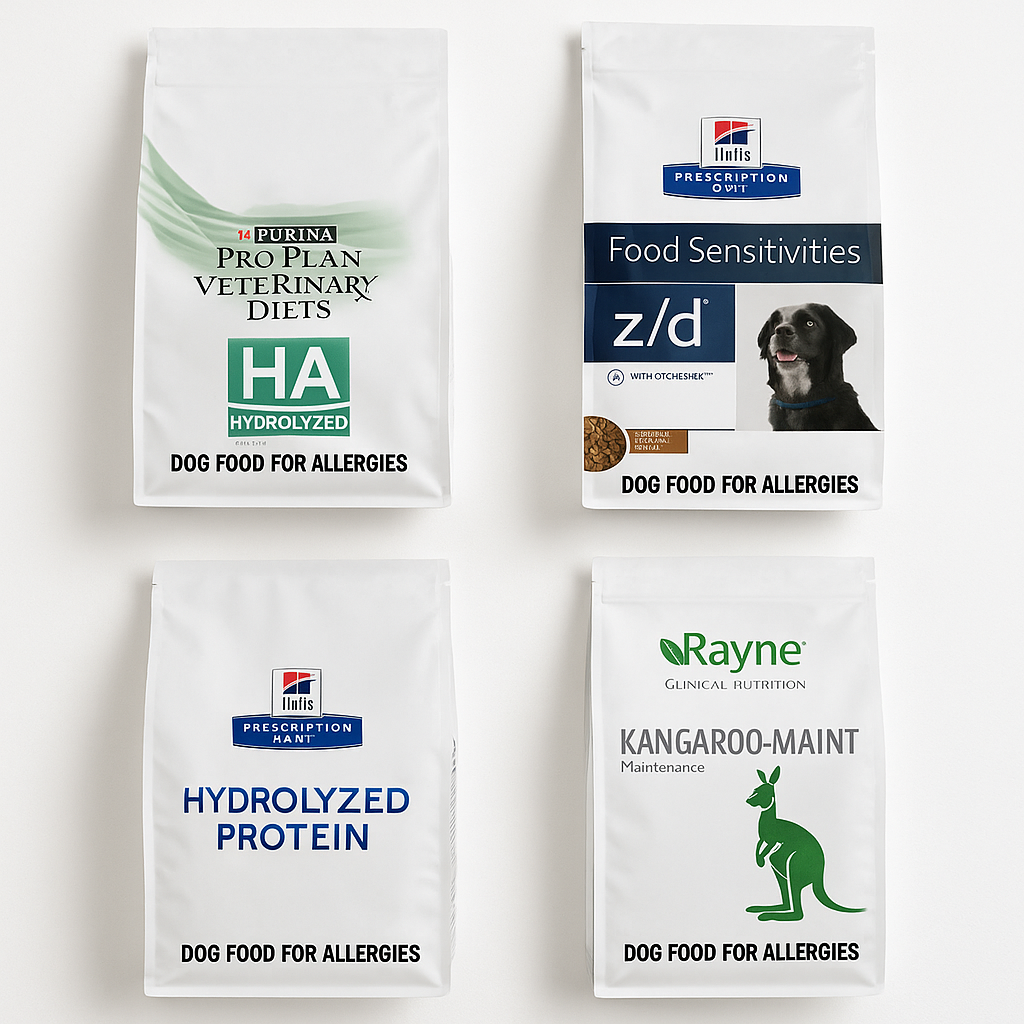
Whether you’re buying prescription food or a commercial limited-ingredient diet, knowing how to decode a label is essential when selecting dog food for allergies. Ingredients can be misleading — and allergens often hide in plain sight.
Ingredients to Look For
✅ Named protein source: Look for specific meat names like “duck” or “venison” instead of vague terms like “meat meal” or “animal digest.”
✅ Single carbohydrate source: Ideally something easy to digest (e.g., rice, sweet potato).
✅ Limited ingredients: Fewer components reduce the risk of exposure to allergens.
✅ AAFCO Statement: Ensures the food is complete and balanced for your dog’s life stage.
✅ No added flavors or by-products: “Natural flavor” or “beef fat” can hide allergens.
Red Flags and Misleading Claims
Be skeptical of the following unregulated or loosely defined terms:
🚫 “Hypoallergenic” — not a protected term
🚫 “Veterinarian approved” — may not reflect real clinical testing
🚫 “Natural” or “Holistic” — sounds healthy, but lacks scientific meaning
🚫 “Grain-Free” — doesn’t help unless your dog is grain-sensitive (rare)
🚫 “Human-grade” — doesn’t guarantee allergy safety
Even high-end “natural” foods can be packed with common protein allergens. If your dog’s current dog food for allergies includes beef, chicken, or dairy under vague names, it’s time for a change.
Also, beware of cross-contamination: many non-prescription brands are produced on shared lines with allergenic ingredients. This makes prescription diets the safest for true elimination trials.
Prevention and Long-Term Management
Once you’ve found a dog food for allergies that works, the key to long-term success is consistency. Even tiny exposures to the allergen can trigger symptoms again. Managing a food allergy is all about being proactive and precise.
5-Minute Home Checklist
Use this daily checklist to stay on track:
✅ Feed only the prescribed or recommended dog food for allergies
✅ Avoid treats, table scraps, and flavored chews
✅ Wash food and water bowls with hot, soapy water daily
✅ Store food in an airtight container to prevent contamination
✅ Remind guests and kids not to feed your dog human food
Avoiding Accidental Exposures
Common ways allergens sneak back into your dog’s life:
- Flavored medications (check for beef or chicken bases)
- Dental chews or rawhides with hidden animal products
- Dropped food or table scraps
- Pet sitters/daycare not following feeding rules
- Multi-pet households with shared food bowls
Tip: Use the main dog food for allergies as a treat — break kibble into smaller pieces to reward without risk.
Vet Monitoring and Skin Support
Even with the right food, ongoing support is helpful:
- Recheck with your vet every 6–12 months
- Track weight and adjust portions as needed
- Consider omega-3 fatty acid supplements (from fish oil or algae)
- Monitor for signs of relapse (itching, GI upset)
A consistent, allergy-safe routine helps keep your dog healthy, happy, and symptom-free — without the need for constant medication.
Frequently Asked Questions
What’s the best dog food for allergies?
The best dog food for allergies depends on your dog’s health history and symptoms. Most veterinarians recommend starting with a hydrolyzed protein or novel protein diet. Prescription diets like Hill’s z/d or Royal Canin HP are ideal for diagnosis. For long-term feeding, a carefully chosen limited ingredient or balanced homemade diet may work under veterinary guidance.
Can I feed raw or homemade diets to allergic dogs?
Yes, but only with veterinary supervision. Homemade diets must be nutritionally complete, often needing calcium and vitamin supplements. Raw diets are not recommended for immune-compromised dogs due to bacterial risks. Always use a tool like BalanceIT and get your vet’s input when choosing a homemade dog food for allergies.
Are grain-free diets better for food-allergic dogs?
Not usually. Most dog food allergies are caused by animal proteins, not grains. Grain-free options can sometimes introduce legumes like peas or lentils, which may be harder to digest or linked to heart issues (DCM). Unless your dog has a true grain allergy (rare), grain-inclusive dog food for allergies is just as safe.
How soon will my dog improve on a new food?
Most dogs start to show improvement within 6–8 weeks of starting an elimination diet. Digestive symptoms often resolve first, while skin issues can take the full 12 weeks. Be patient and don’t introduce other foods during this period.
Do allergy shots help with food allergies?
No. Allergy injections (immunotherapy) are used for environmental allergies, like pollen or dust mites. They do not work for food allergies. Avoidance is the only proven method — which is why the right dog food for allergies is crucial.
Can food allergies be cured?
Unfortunately, no. Food allergies are lifelong, but they are highly manageable. With the right diet, your dog can live a completely normal, itch-free life without daily medications.
Final Thoughts: Managing Food Allergies for Life
Food allergies can be frustrating, but they don’t have to control your dog’s life. With the right dog food for allergies, you can reduce vet visits, eliminate chronic symptoms, and give your pet the comfort they deserve. Whether you go with a prescription hydrolyzed protein, a well-sourced novel protein, or a balanced homemade option, the key is consistency. Avoiding allergens — even in small treats — is the only way to keep symptoms away long-term.
As a vet, I’ve seen itchy, miserable dogs transform into relaxed, happy pets — often within weeks of starting the right diet. Don’t give up if the first food doesn’t work. Work closely with your vet, follow the elimination plan fully, and stay patient. Remember, the right dog food for allergies isn’t just about ingredients — it’s about restoring your dog’s health and quality of life.

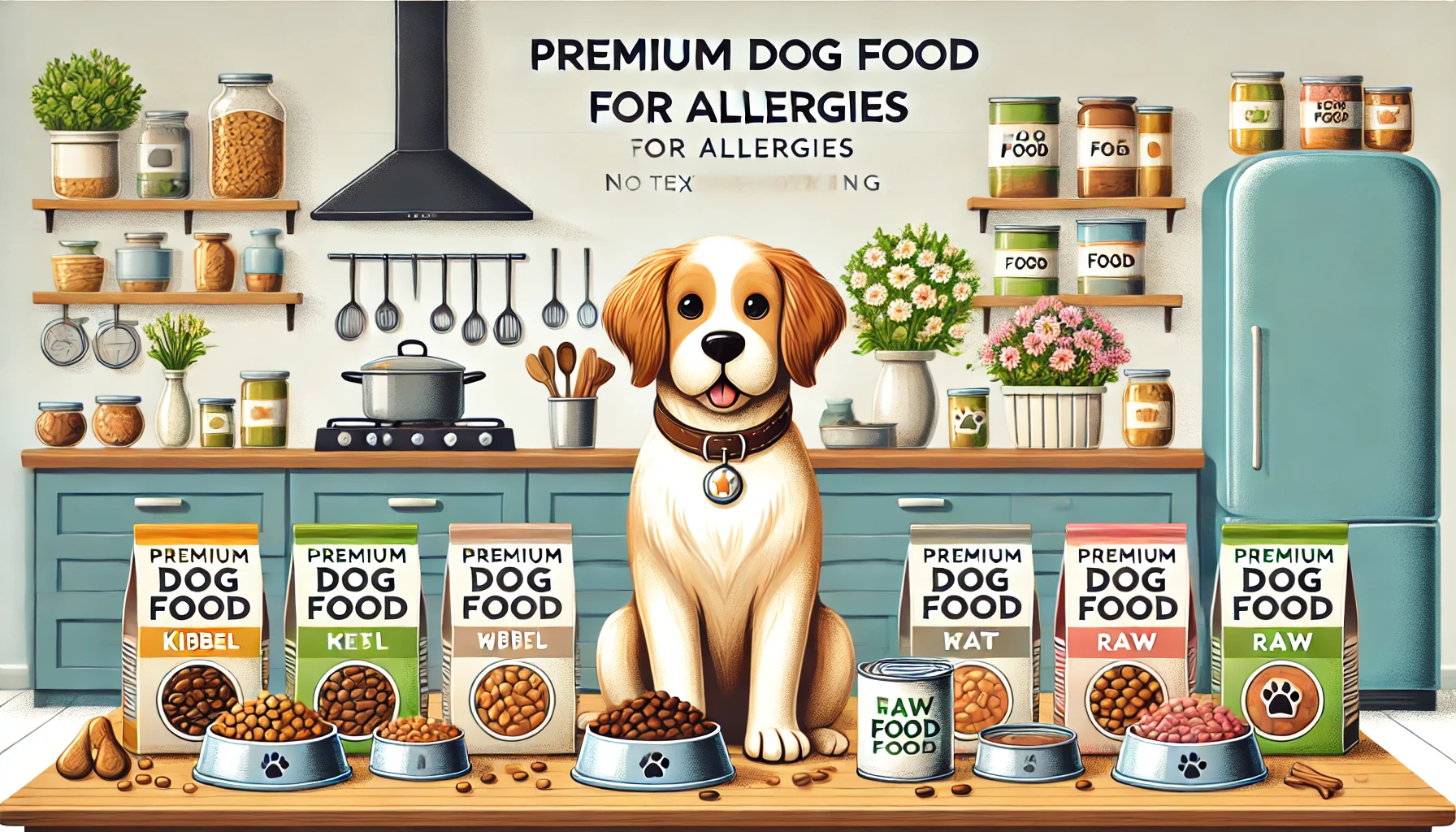
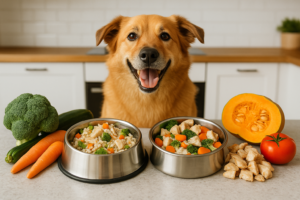
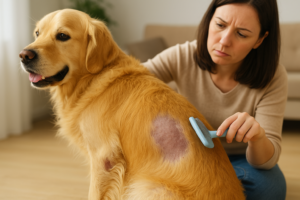

Pingback: 2025 Dog Exercise Needs Explained: How Much Activity Is best for Your Pet?